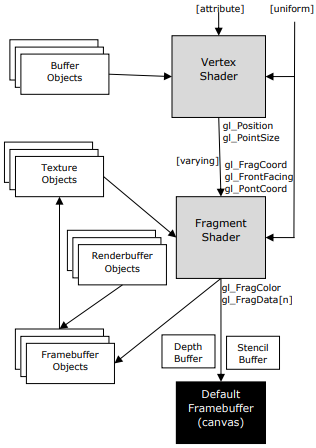WebGL
(2025-09-21T12:16.260Z)
Perplexity Query
(2025-09-21T12:16
.260Z)
Question:
Write a comprehensive one-page article about "WebGL".
Model: sonar-pro
WebGL: The Backbone of Browser-Based 3D Graphics
WebGL, short for Web Graphics Library, is a powerful JavaScript API that enables interactive 2D and 3D graphics in web browsers without the need for additional plug-ins.
[sp4cyx]
[1kg64l]
Its significance lies in its ability to use hardware acceleration via the Graphics Processing Unit (GPU), allowing developers to deliver complex and immersive visual experiences directly through the browser—a major leap for web-based games, data visualization, and multimedia applications.
[sp4cyx]
[dt0s8m]

What Is WebGL and How Does It Work?
At its core, WebGL is based on OpenGL ES, a graphics standard originally created for mobile devices, now embedded in most modern browsers such as Chrome, Firefox, Safari, and Edge.
[sp4cyx]
[1kg64l]
[dt0s8m]
Developers write WebGL programs in JavaScript, with shader code in GLSL (OpenGL Shading Language), which runs on the user's GPU for efficient rendering.
[sp4cyx]
Unlike earlier web graphics solutions that required plugins like Flash or Java, WebGL is natively built into the browser. This enables seamless integration with HTML5’s canvas element and other web technologies, allowing interactive graphics to be embedded and composited with web pages.
[sp4cyx]
[dt0s8m]
Libraries such as Three.js and Babylon.js simplify development, providing higher-level abstractions to accelerate and democratize WebGL-based projects.
[1kg64l]
Practical Examples and Use Cases
WebGL's versatility is evident in a range of applications:
- Web-Based Games: Many online games run directly in the browser with realistic 3D environments, leveraging WebGL’s GPU processing for real-time graphics.
- Scientific and Medical Visualization: Researchers visualize complex data sets, molecular models, or anatomical structures interactively, aiding analysis and education. [1kg64l]
- Product Demos and Virtual Tours: Retailers offer immersive previews of products or spaces, letting users interact in 3D before making a decision.
- Educational Tools: Interactive textbooks, simulations, and virtual labs use WebGL to make abstract concepts tangible.
- Art and Creative Installations: Artists build browser-based installations and experiences that respond dynamically to user inputs.

Benefits and Potential Applications
Key benefits include:
- Integration: It works with other web APIs (such as WebAudio or WebRTC) to create fully interactive experiences. [1kg64l]
- Community and Resources: A large developer community, comprehensive documentation, and open-source frameworks aid adoption and innovation. [1kg64l]
Challenges and Considerations
Despite its strengths, WebGL poses several challenges:
- Development Complexity: The low-level API requires knowledge of graphics programming and shader development; frameworks can help but may not cover all needs. [1kg64l]
- Browser and Hardware Compatibility: While most modern devices support WebGL, some older devices or browsers may have limited features or performance.
- Security: WebGL applications run sandboxed to prevent malicious activity, but flaws in implementation can still pose risks. [dt0s8m]
Current State and Trends
WebGL is widely adopted and supported by all major browsers, making it a default choice for web-based interactive graphics.
[sp4cyx]
[1kg64l]
The latest version, WebGL 2.0, brings enhancements such as better texture management and support for 3D textures, further expanding possibilities.
[sp4cyx]
[1kg64l]
Popular frameworks like Three.js and Babylon.js are driving mainstream adoption by lowering technical barriers.
[1kg64l]
However, the field is shifting as the Khronos Group—the organization behind WebGL—develops WebGPU, a next-generation API offering modern capabilities and deeper GPU access for advanced graphics and AI applications.
[sp4cyx]
Recent developments include:
- Mobile Optimization: WebGL’s effective cross-platform support now achieves high performance on mobile devices, broadening its use. [1kg64l]
- Integration with AR/VR: Combining WebGL with WebXR and other APIs is enabling rich virtual and augmented reality experiences directly in the browser. [1kg64l]

Future Outlook
With the advent of WebGPU, web graphics are poised for another leap, allowing even more sophisticated rendering, machine learning tasks, and immersive XR experiences in-browser.
[sp4cyx]
As browsers and hardware evolve, expect WebGL and its successors to power seamless, real-time graphics for gaming, education, design, and communication—heralding a future where the web itself becomes a platform for interactive visualization and creative collaboration.
In summary, WebGL transforms the browser into a dynamic canvas for 2D and 3D graphics, empowering developers and creators to deliver immersive, interactive experiences to audiences worldwide. Its ongoing evolution promises even richer possibilities for the future of web-based visual computing.
Citations
[sp4cyx] 2025, Sep 13. WebGL - Wikipedia. Published: 2009-09-14 | Updated: 2025-09-13
[1kg64l] 2025, Sep 07. WebGL definition and description. Published: 2025-04-02 | Updated: 2025-09-07
[dt0s8m] 2025, Sep 19. OpenGL & WebGL: Graphics Rendering in Native and Web. Published: 2024-07-21 | Updated: 2025-09-19
[4]: 2025, Jun 27. WebGL: 2D and 3D graphics for the web - Web APIs - MDN. Published: 2025-06-26 | Updated: 2025-06-27
[5]: 2025, Sep 20. What is WebGL technology for web-based 3D graphics and what is .... Published: 2023-04-19 | Updated: 2025-09-20
[7]: 2025, Sep 16. An Introduction to WebGL - Thoughtbot. Published: 2022-02-09 | Updated: 2025-09-16